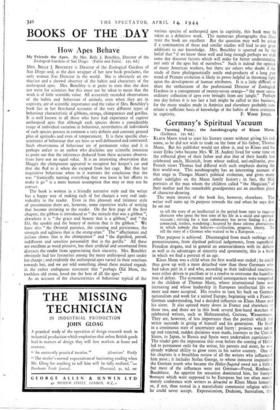BOOKS OF THE DAY
How Apes Behave •
MRS. BELLE J. BENCHLEY is Director of the Zoological Gardens of San Diego and, as the dust wrapper of her new book proclaims, the
only woman Zoo Director in the world. She is obviously an en- thusiast and a shrewd observer of the habits and characters of the. anthropoid apes. Mrs. Benchley is at pains to state that she does not write for scientists but this must not be taken to mean that the work is of little scientific value. All accurately recorded observations of the habits and behaviour of animals, even when they are in captivity, are of scientific importance and the value of Mrs. Benchley's book lies in her first-hand accounts of the very different types of behaviour characteristic of gibbons, orangs, chimpanzees and gorillas. It is well known to all those who have had experience of captive anthropoid apes that although each species shows a considerable range of individual variation in behaviour, nevertheless all individuals of each species possess in common a very definite and constant ground plan of aptitudes and even of temperament. It is these specific char- acteristics of behaviour that are here so well delineated and contrasted. Such observations of behaviour are of permanent value and it is perhaps unfair to an author who disclaims any scientific intention to point out that the inferences deduced from these accurate observa- tions have not an equal value. It is an interesting observation that Maggie the chimpanzee appeared to recognise her keeper's car and that she fled to it when she escaped from her cage. But that her inquisitive behaviour when in it warrants the conclusion that she was "frantically turning everything that was loose in her efforts to make it go" is a mere human assumption that may or may not be correct.
The book is written in a friendly narrative style and the writer has a happy way of making each of her charges a very real indi- viduality to the reader. Even in this pleasant and intimate style of presentation there are, however, some repetitive tricks of writing that become irritating to the reader. On the first page of the first chapter, the gibbon is introduced as "the miracle that was a gibbon "; elsewhere it is "the grace and beauty that is a gibbon," and "the life, the sparkle and the beauty of motion that is the gibbon." We have also "the Oriental patience, the cunning and persistence, the strength and ugliness that is the orang-utan." The "affectionate and jealous clown that is the chimpanzee" and "the dignified, poised, indifferent and sensitive personality that is the gorilla." All these are excellent as word pictures, but their artificial and ornamental form distracts the reader from appreciating their sincerity. Mrs. Benchley obviously had her favourites among the many anthropoid apes under her charge ; and evidently the anthropoid apes varied in their reactions towards her, and we are told something about these mutual regards in the rather ambiguous statement that "perhaps Old Mom, the toothless old crone, loved me the best of all the apes."
As an account of the characteristics of behaviour typical of the
various species of anthropoid apes in captivity, this book may be taken as a definitive work. The numerous photographs that illus- trate the book are excellent. But the question may well be asked if a continuation of these and similar studies will lead to any great additions to our knowledge. Mrs. Benchley is spurred on by the belief that "if we know them well and long enough perhaps we shall some day discover factors which will make for better understanding not only of the apes but of ourselves." Such is indeed the opinion of many American workers, but there are others who doubt if the study of these phylogenetically senile end-products of a long past trend of Primate evolution is likely to prove helpful in throwing light upon the development of human attributes. It is a little difficult to share the enthusiasm of the professional Director of Zoological Gardens in a consignment of twenty-seven orangs—" the most extra- ordinary collection of apes ever brought from any jungle." Perhaps one day before it is too late a halt might be called to this business, for the many studies made in Am-erica and elsewhere probably con- stitute a sufficient basis of knowledge of the habits of these creatures


























 Previous page
Previous page